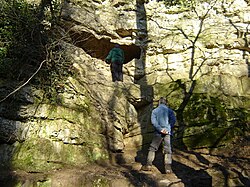| Kirkdale Cave | |
|---|---|
 Entrance to Kirkdale Cave | |
| Location | Vale of Pickering, North Yorkshire, England |
| OS grid | SE 6784 8560 |
| Coordinates | 54°15′42″N 0°57′36″W / 54.261588°N 0.960088°W |
| Length | 436 metres (1,430 ft)[1] |
| Elevation | 58 metres (190 ft)[1] |
| Discovery | 1821 |
| Geology | Jurassic Corallian Limestone |
| Entrances | 1 |
| Access | Entrance is in face of old quarry |
Kirkdale Cave is a cave and fossil site located in Kirkdale near Kirkbymoorside in the Vale of Pickering, North Yorkshire, England. It was discovered by workmen in 1821, and found to contain fossilized bones of a variety of mammals from the Eemian interglacial, when temperatures were comparable to contemporary times, including animals currently absent from Britain or globally extinct, including hippopotamuses (the farthest north any such remains have been found), straight-tusked elephants, the narrow-nosed rhinoceros, and cave hyenas.
William Buckland analyzed the cave and its contents in December 1821 and determined that the bones were the remains of animals brought in by hyenas who used it for a den, and not a result of the Biblical flood floating corpses in from distant lands, as he had first thought. His reconstruction of an ancient ecosystem from detailed analysis of fossil evidence was admired at the time, and considered to be an example of how geo-historical research should be done.
The cave was extended from its original length of 175 metres (574 ft) to 436 metres (1,430 ft) by Scarborough Caving Club in 1995. A survey was published in Descent magazine.[1]

